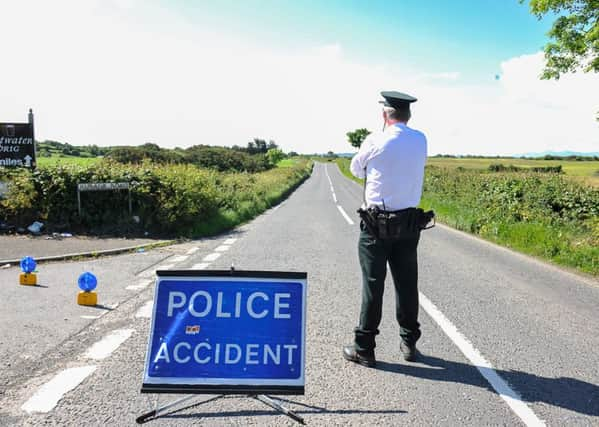Way paved for raft of new road rules '“ but minister admits some are complex


The Road Traffic (Amendment) Bill was passed by the Assembly this week, and includes plans for a lower drink-drive limit, revised rules around being breathalysed, and restrictions on learner and recently-qualified drivers (see below).
Although Northern Irish road deaths have reduced dramatically over the decades, with annual death tolls often exceeding 300 during the years of the 1970s, Environment Minister Mark H Durkan noted that 74 people had lost their lives as a result of traffic accidents.
Advertisement
Hide AdAdvertisement
Hide AdOn Wednesday he said in a statement: “We cannot, if at all possible, let this carnage continue. What I have done in this Bill is to get to the root causes of the problem.
“That means tougher drink drive laws. That means ensuring our new drivers are better drivers. That means putting less young people at risk in the hands of novice drivers.”
Many rules target younger and less-experienced drivers, whom the minister said “are significantly over-represented in road traffic collisions”.
He concluded by declaring that there is “no acceptable level of road deaths”.
Advertisement
Hide AdAdvertisement
Hide AdHowever, although the Bill has now been passed, to Department of the Environment said none of it is yet in force.
Elements of the Bill will still be subject to public consultation, and parts of it are not likely to be in place until 2018.
One part of the Bill which has previously attracted attention is the restriction on the numbers of passengers those aged under 24 can carry.
For the first six months after they pass their test, such drivers will be able to carry only one passenger aged 14 to 20 between 11pm and 6am.
Advertisement
Hide AdAdvertisement
Hide AdThere are exceptions, such as immediate family members, those for whom the driver is a carer, or if a passenger in the front passenger seat is 21 or older and has held a full licence for three years or more. The restriction also does not apply if the vehicle is being in an emergency.
Previously, Mr Durkan has said: “I recognise and accept the difficulty that this would present to police, to drivers and to passengers.”
During discussions about the Bill in the week, Alliance MLA Anna Lo said that initially the minister wanted it to apply 24 hours, but that it had been amended to apply only to the night time.
Mr Durkan told the Assembly on Tuesday he was “conscious of the need to improve road safety without unduly impacting on mobility”.
Advertisement
Hide AdAdvertisement
Hide AdWhile “some of the provisions – in particular the passenger restrictions on new young drivers – are more complex than I would have liked”, he believed the Bill “struck the right balance”.
AT A GLANCE:
The 37-page Bill allows for a raft of measures to be drawn up and put into place, including the following.
• Many of the new rules relate to what the Department of the Environment (DoE) calls “Graduated Driver Licensing” – or GDL for short.
• Among these are the restrictions on the number of passengers which young drivers can carry, as detailed above.
Advertisement
Hide AdAdvertisement
Hide Ad• But the act also lays out a minimum mandatory learning period for new drivers of six months.
• So while the provisional licensing age will remain at 17, in combination with the six month minimum period, the DoE said “the full licensing age will effectively rise to 17-and-a-half”.
• Learning will also involve the completion of what the DoE terms a “compulsory student logbook”.
• However, while tightening the law in some respects, the DGL provisions also include the removal of the 45mph restriction on learner drivers and restricted drivers.
Advertisement
Hide AdAdvertisement
Hide AdThis means learners will be able to take driving lessons on motorways.
• A public consultation on these measures is expected to be launched before the summertime, but the DoE told the News Letter it is “likely to be early 2018 before GDL becomes operational due to the package of measures which require consultation and subordinate legislation”.
• Meanwhile the bill also has new drink-driving limits.
• Instead of being 80mg per 100mls as standard, it will become 50mg per 100mls for most drivers, and 20mg per 100ml for learner drivers, and professional drivers;
• A new graduated penalty system will provide for fixed penalties for first-time offenders whose breaches are at a lower level, and “continued court prosecution for high level first offences, or any second or subsequent offences”.
Advertisement
Hide AdAdvertisement
Hide Ad• Drivers will no longer be able to opt for a blood or urine sample to replace a breath sample in cases where they have failed a breathalyser by only a small margin.
• The DoE said it also gives police the power to set up roadside check-points to breathalyse drivers.
• It also provides for the automatic referral of offenders onto an approved Course for drink-driving offenders (although attendance will be voluntary), unless a judge decides such a referral is inappropriate.
• The DoE told the News Letter that “the consultation in relation to the drink-drive measures is expected to issue within the next couple of months”. The Bill,